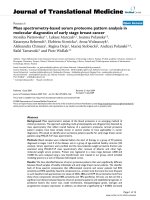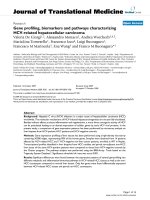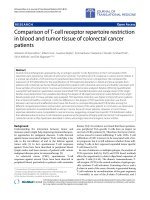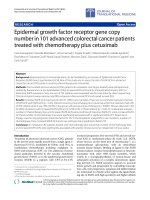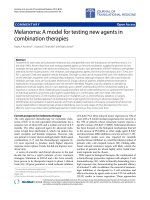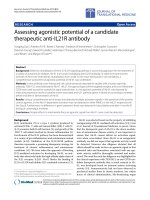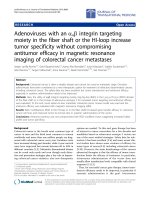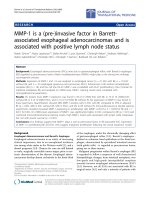báo cáo hóa học: " Do functional walk tests reflect cardiorespiratory fitness in sub-acute stroke?" pptx
Bạn đang xem bản rút gọn của tài liệu. Xem và tải ngay bản đầy đủ của tài liệu tại đây (340.37 KB, 9 trang )
BioMed Central
Page 1 of 9
(page number not for citation purposes)
Journal of NeuroEngineering and
Rehabilitation
Open Access
Research
The effects of moderate fatigue on dynamic balance control and
attentional demands
Martin Simoneau*, François Bégin and Normand Teasdale*
Address: Groupe de Recherche en Analyse du Mouvement et Ergonomie, Faculté de Médecine, Division de kinesiology, Université Laval, Québec,
Canada
Email: Martin Simoneau* - ; François Bégin - ;
Normand Teasdale* -
* Corresponding authors
Abstract
Background: During daily activities, the active control of balance often is a task per se (for
example, when standing in a moving bus). Other constraints like fatigue can add to the complexity
of this balance task. In the present experiment, we examined how moderate fatigue induced by fast
walking on a treadmill challenged dynamic balance control. We also examined if the attentional
demands for performing the balance task varied with fatigue.
Methods: Subjects (n = 10) performed simultaneously a dynamic balance control task and a probe
reaction time task (RT) (serving as an indicator of attentional demands) before and after three
periods of moderate fatigue (fast walking on a treadmill). For the balance control task, the real-time
displacement of the centre of pressure (CP) was provided on a monitor placed in front of the
subject, at eye level. Subjects were asked to keep their CP within a target (moving box) moving
upward and downward on the monitor. The tracking performance was measured (time spent
outside the moving box) and the CP behavior analyzed (mean CP speed and mean frequency of the
CP velocity).
Results: Moderate fatigue led to an immediate decrement of the performance on the balance
control task; increase of the percentage of time spent outside the box and increase of the mean
CP speed. Across the three fatigue periods, subjects improved their tracking performance and
reduced their mean CP speed. This was achieved by increasing their frequency of actions; mean
frequency of the CP velocity were higher for the fatigue periods than for the no fatigue periods.
Fatigue also induced an increase in the attentional demands suggesting that more cognitive
resources had to be allocated to the balance task with than without fatigue.
Conclusion: Fatigue induced by fast walking had an initial negative impact on the control of
balance. Nonetheless, subjects were able to compensate the effect of the moderate fatigue by
increasing the frequency of actions. This adaptation, however, required that a greater proportion
of the cognitive resources be allocated to the active control of the balance task.
Published: 28 September 2006
Journal of NeuroEngineering and Rehabilitation 2006, 3:22 doi:10.1186/1743-0003-3-22
Received: 21 April 2006
Accepted: 28 September 2006
This article is available from: />© 2006 Simoneau et al; licensee BioMed Central Ltd.
This is an Open Access article distributed under the terms of the Creative Commons Attribution License ( />),
which permits unrestricted use, distribution, and reproduction in any medium, provided the original work is properly cited.
Journal of NeuroEngineering and Rehabilitation 2006, 3:22 />Page 2 of 9
(page number not for citation purposes)
Background
Fatigue alters the force capacity of muscles. It is a complex
and diverse phenomenon involving neural and muscular
mechanisms [1,2]. At the ankle, it decreases the sense of
position [3,4] and the control of balance. For example,
Lundin et al. [5], have examined how plantar flexor and
dorsiflexor fatigue induced through an isokinetic protocol
affected the control of balance. They reported a significant
increase in medio-lateral (M-L) body sway oscillations
amplitude compared with a no fatigued state. Similar
observations have been reported by others [6-8].
More global fatigue protocols where fatigue is induced by
treadmill walking or skiing, running or cycling also have
been used [9-11]. For example, Nardone et al. [9], using a
treadmill aerobic fatigue protocol, have reported increases
of the sway path of the centre of pressure (CP) and
median frequency of the CP velocity after the fatigue pro-
tocol. The latter effect suggested the authors that fatigue
induces an increased frequency of actions needed to regu-
late body sway oscillations. Simoneau et al. [11] tested the
balance stability of recreational and highly skilled biathe-
letes in their upright shooting position before and after a
metabolic activation similar to that observed in competi-
tion. They reported that skilled athletes were less affected
by fatigue suggesting that skill could attenuate the specific
effect of fatigue on balance control.
Fatigue also alters central processing of proprioception
[12,13]. With fatigue, cortico-motor neuronal cells firing
rates decrease and motor-evoked potentials increase sug-
gesting inadequate cortical output [see [1], for review].
Besides, central fatigue may induce deterioration of cogni-
tive functions. For example, following mental fatigue,
subjects are still able to perform automated tasks but per-
formance in complex tasks deteriorates [14]. Also, when
producing submaximal contractions at the elbow, a con-
stant force production can be obtained at the cost of
increasing central command intensity. This process is not
automatic and Lorist et al. [13] suggested the presence of
a mutual interaction between cognitive functions and the
central mechanisms driving motor behaviour during
fatigue. These authors observed a decline in performance
in a dual-task condition (decreased force production and
increased probe reaction time) compared to single-task.
They suggested that the dual-task condition imposed a
100% workload on the subject's limited attentional
demands. Hence, no residual resources were available to
compensate for the increasing task demands brought in
by the fatigue. Similar interactive processes between cog-
nition and the balance control mechanisms have been
suggested [15-17]. For instance, attentional demands are
greater for unstable than for stable balance conditions
[18-20].
Fatigue does not always lead to task failure. For instance,
the term "light work" has been ascribed to work situations
in which the task requires low energetic expenditure and
in which there are no high peak load to the musculo-skel-
etal system [21]. In the present study, we wanted to exam-
ine how a familiar sub-maximal fatiguing condition, fast
walking, modifies balance control. Also because for most
daily activities, we not only have to stand in a quasi-static
posture but also have to control our CP, which regulates
centre of mass (CM) velocity-position [22,23], we have
designed a balance task requiring an active control of CP
displacements. Based on the work of Lorist et al. [13], we
hypothesized the effect of moderate fatigue on balance
control could be compensated. This, however, would
come at the expense of greater attentional demands.
Methods
Results
Subjects
Ten healthy young adults (six males and four females,
mean age: 22.6 ± 1.7 yr, mean height: 1.72 ± 0.09 cm, and
mean weight: 73.6 ± 14.8 kg) participated in the experi-
ment. None of the participants were familiar with the pur-
pose of the experiment. All participants gave written
consent according to Laval University ethic committee.
Tasks and apparatus
Participants stood on a force platform (AMTI OR6-1), two
meters from a 17-in monitor placed at gaze level. The CP
was calculated in real-time to provide a direct feedback
about the position and displacement through a moving
red cross (10 mm × 10 mm). A forward displacement of
the subject induced a movement of the cross in the
upward direction while a backward displacement created
a downward movement of the cross. Left and right move-
ments of the cross corresponded to left and right displace-
ments of the CP. The subject's task consisted of
maintaining the red cross within a squared box (20 mm ×
20 mm) moving upward and downward for a period of 30
sec.
All subjects were instructed their primary task was to reg-
ulate their balance and to keep their CP within the mov-
ing box. While performing the postural task, they
performed a secondary probe reaction time (RT) task.
They responded vocally ("top") as rapidly as possible to
an unpredictable auditory stimulus. RT was defined as the
temporal interval between the presentation of an auditory
stimulus (100 ms, 1.5 kHz) and the onset of the verbal
response (detected from the analog signal of a piezoelec-
tric microphone ["Realistic", FM Wireless Microphone
System]) mounted on a custom headset. The force plat-
form signals, the auditory stimuli, and the vocal responses
were all sampled at 500 Hz (16-bit A/D conversion
National Instrument model PCI-6052E).
Journal of NeuroEngineering and Rehabilitation 2006, 3:22 />Page 3 of 9
(page number not for citation purposes)
Normalization procedures
Prior to the testing, four different activities, lasting about
45 minutes, took placed: 1) a calibration procedure to
determine the amplitude and speed of the moving box, 2)
a practice session to learn tracking the moving box, 3)
data acquisition of baseline RTs, and 4) a familiarization
period with the treadmill also serving to determine the
maximal walking speed. These four activities are now
described.
The calibration procedure allowed setting the amplitude
and speed of the moving box (Fig. 1A – Calibration). Sub-
jects were asked to lean forward and backward as far and
as fast as possible and to move back to their neutral initial
position. When doing so, they were instructed to adopt an
inverse pendulum strategy (rotation around the ankle
joint and minimize hip and knee movements) and were
not allowed to take a step or raise their heels and toes. The
amplitude of the trajectory of the moving box along the
upward and downward direction was equal to 30% of the
maximal backward and forward leaning amplitude,
respectively. For all subjects, the mean amplitude of the
trajectory was 6.9 cm and it varied from 5.1 to 8.9 cm. The
velocity of the box represented 8% of the maximal veloc-
Schematic representation of the five experimental sessionsFigure 1
Schematic representation of the five experimental sessions. A) Normalization procedure before the experiment.
First, the dynamic balance control capabilities of each subject were quantified to determine the amplitude and velocity of the
moving box (Calibration). Then, subject rested for 5-min. To avoid possible learning effect during the main experiment, sub-
jects performed 40 trials followed by a 5-min rest period (Practice session). Then, baseline reaction times were collected
(Baseline RT). Finally, subjects walked on the treadmill to determine maximum treadmill velocity of each subject (Familiariza-
tion). B) Main experiment. The first two blocks are without fatigue (No fatigue 1 and No fatigue 2). There was a 2 minutes rest
period between both blocks of no fatigue. The next three blocks composed the fatigue condition (Fatigue 1, Fatigue 2 and
Fatigue 3). The gray areas before each of the three block of fatigue correspond to the fast walking periods. After the last block
of no fatigue (No fatigue 2), subjects started the first fast walking session (gray area). When they could not keep the pace with
the treadmill, they started tracking the moving box for 10 30-s trials. They repeated this procedure twice. C) Within trial.
Before each trial, a two seconds period of data acquisition served to align the centre of the moving box with the average cen-
tre of pressure calculated during this period. This 2-s period was not included in the centre of pressure data analysis. Each trial
lasted 30 seconds.
Data acquisition
30-s trial
2-s
Calibration
FamiliarizationPractice session
No fatigue 1
No fatigue 2
Fatigue 1
Fatigue 2
Fatigue 3
No fatigue
fatigue
Fast walking session
2-min rest period
C – Within trial
B – Main experiment
A – Before the experiment
5-min rest period
Baseline RT
Journal of NeuroEngineering and Rehabilitation 2006, 3:22 />Page 4 of 9
(page number not for citation purposes)
ity noted for the backward leaning (that is the minimum
of the two maximum velocities performed in the forward-
backward leaning). The average speed was 1.86 cm/s.
Across subjects, it varied from 0.85 to 3.60 cm/s. For the
experimental trials, the box presented on the monitor fol-
lowed a continuous upward-downward linear trajectory
at a constant speed for 30 seconds. By normalizing the tar-
get's displacement and speed, we wanted to make sure
these parameters would be adjusted to each subject's
dynamic balance control capabilities.
During a pilot study (n = 3 subjects), we observed that 40
trials were necessary to attain a stable tracking perform-
ance (Time out of the target). For this reason, each subject
received 40 practice trials (30 sec each) following the cal-
ibration procedure (Fig. 1A – Practice session). Data for
these 40 practice trials are not reported herein as their
only purpose was to ensure all subjects had attained a sta-
ble level of performance prior to the experiment.
A 5-min rest period was then provided and baseline RTs
were collected (Fig. 1A – Baseline RT). In the present
experiment, subjects were asked to consider the postural
task as their primary task. The RT task was the secondary
task and any change in RT presumably would reflect
changes in the attentional demands necessary to perform
the postural task. RT was defined as the temporal interval
between the presentation of the auditory stimulus and the
onset of the verbal response (detected from a voltage rise
in the analog signal of the microphone). For the baseline
RTs, subjects were seated comfortably and 12 auditory
stimuli were given randomly within a 3-min period. They
responded vocally ("top") as rapidly as possible to the
auditory stimulus.
Finally, familiarization with the treadmill was provided
(Fig. 1A – Familiarization). This also served to determine
each subject's maximal walking speed. We started with a
treadmill speed of 1.33 m/s and gradually increased it by
step of 0.044 m/s until the subject was forced to jog to
keep up with the treadmill speed. This also served as a
warm-up period. The treadmill speed was then adjusted to
the fastest speed observed in the warm-up period. Normal
gait speed is around 1.2 m/s. Our subjects walked at
speeds nearly twice that fast (from 2.01 m/s to 2.37 m/s,
see results section). A 5-min rest period followed these
procedures.
Experimental procedures
The unfolding of the experimental conditions that fol-
lowed the normalization procedures is illustrated in Fig-
ure 1B. The experiment started with two blocks of 10 30-s
tracking trials without fatigue separated by a short rest
period (2 min). Before each trial, the participants were
asked to keep their arms along their body and stood as
still as possible for two seconds. This procedure served to
align the centre of the moving box with the average CP cal-
culated for this period. These data were not included in
the analysis. Data acquisition (30 sec) followed without
any delay. For each trial, 3 or 4 randomly presented audi-
tory stimuli separated by at least 4 sec were given. A total
of 35 stimuli were given for each series of 10 trials.
The three walking (fatigue) periods followed. For each fast
walking period (gray areas in Fig. 1B), the participants
walked on a treadmill (StarTrac, model 3021, Unisen Inc.,
Tustin, CA, USA) at their maximal speed as long as they
could maintain the pace while avoiding running. Subjects
were verbally encouraged to maintain their pace. Warn-
ings were given when the participants got beyond a prede-
termined backward spatial boundary on the treadmill or
when they jogged to keep the pace. Each walking period
stopped at the second warning. A block of ten balance
tracking trials immediately followed. This sequence (fast
walking-balance tracking trials) was repeated three times.
The duration of the experiment (excluding the normaliza-
tion procedures) was about 1 hour.
Data analyses
Dynamic balance control
The ability of the participants to control their CP with and
without moderate fatigue was determined for each trial by
calculating a) the percentage of time spent outside the
moving box for both the antero-posterior (A-P) and
medio-lateral (M-L) axes, b) the mean speed of the CP,
and c) the mean frequency of the CP velocity. Mean speed
corresponds to the cumulated distance over the sampling
period and it is a good index of the activity required to
control balance. Before calculating the mean frequency,
we removed the imposed A-P movement of the target
from the A-P oscillations. Therefore, the remaining A-P
signal consisted of the specific body oscillations of the
subjects needed to keep the CP within the moving box.
We focused on the CP oscillations along the A-P axis as the
moving target moved only along this axis. Then, the deriv-
ative of the CP displacement was calculated using a finite
difference technique (55-ms weighted window). Power
spectra were calculated from smoothed detrended data of
the A-P CP velocity using a no overlapping Fast Fourier
Transform (FFT) window of 4096 points allowing a reso-
lution of 0.06 Hz. The mean frequency was calculated
from the power spectra of each trial to characterize the fre-
quency of actions of the CP velocity.
Balance control analyses
Calculated values for each variable were averaged across
the ten trials for each block (two no-fatigue and three
fatigue blocks). For all dependent variables, a one-way
analysis of variance (ANOVA) with repeated measures
(i.e., two no-fatigue and three fatigue blocks) was used.
Journal of NeuroEngineering and Rehabilitation 2006, 3:22 />Page 5 of 9
(page number not for citation purposes)
Whenever the ANOVA reached a significant level, planned
comparisons were used to determine: 1) if the two blocks
of no fatigue differed from the three blocks of fatigue, 2)
if across fatigue, subjects improved their tracking perform-
ance (e.g. decrease of the time spent outside the moving
box) and changed their balance control strategy (e.g.,
increase of their frequency of actions), and 3) if subjects
were able to compensate the effect of fatigue (by compar-
ing results for the last block of fatigue with that of the no
fatigue blocks. The level of significance was set at P < 0.05.
If moderate fatigue decreases dynamic balance control
ability, a main effect of block should be observed for all
dependant variables (i.e., faster mean speed, longer time
spent outside of the moving box and greater frequency of
actions for the fatigue compared to the no fatigue block).
Reaction time analyses
Balance control is not an automatic task and it requires
cognitive resources [15,16,18]. In the present experiment,
RT served as an indicator of the cognitive (attentional)
demands needed to perform the dynamic balance task.
The traditional approach for analyzing RT consists of cal-
culating the mean of a series of trials. There is a growing
recognition, however, that a more detailed analysis of the
response time distribution provides additional and often
critical information that is not available when using more
standard statistical summary measures of mean and vari-
ance [24-26]. This is particularly the case for human fac-
tors research where one is interested not only in the
average response but in the slowest response. Often, this
slowest response can be associated to a "worst-case" sce-
nario [27]. For instance, the mean RT for responding rap-
idly to critical information presented on a highway sign is
an underestimate of the time necessary to process the
information as all trials with slower RT than that of the
mean presumably could yield to incorrect motor
responses (for example, late braking response or change
of trajectory). A similar logic can be applied to the present
experiment where a) the fastest RTs could allow to deter-
mine if the capability of responding as rapidly as possible
is maintained with fatigue, and b) the slowest RTs could
provide an indication of the "worst-case scenario" where
the attentional demands necessary to regulate the body
sway oscillations have exceeded the normal operating
range. For this reason, we analyzed the 10
th
and 90
th
per-
centile RT for each block of data. These values correspond
more or less to the fastest and slowest RT observed for a
block of data. RT data were submitted to a two-way
ANOVA (Percentile × Block) with repeated measures on
the factor Block. Slower RTs with fatigue would indicate a
greater reliance upon the cognitive process necessary for
body sway oscillations.
For one subject, RTs for trials after the second treadmill
period, failed to be recorded because the piezoelectric
microphone was turned off inadvertently. Hence, for this
subject only, RTs data for the first fatigue block were miss-
ing. Further, two responses (4.068 s and 3.428 s) from
another subject were removed because the subject
reported after the trial that he simply had forgotten
answering to the auditory stimuli.
Results
Walking duration across the three fatigue periods
Subjects walked at a speed varying from 2.01 m/s to 2.37
m/s. The walking duration decreased from the first to the
third period (on average, 10:27, 07:28, 06:06 minutes for
the first, second and third walking period, respectively). A
one-way ANOVA (three treadmill walking periods)
showed that this decrease was statistically significant (F
2,18
= 5.48, P < 0.05) suggesting our walking protocol induced
some fatigue.
Dynamic balance control performance
Results for the time spent outside of the moving box for
both M-L and A-P axes are illustrated in Fig. 2 (upper and
lower panels, respectively). The ANOVAs showed signifi-
cant effects of Block (F
4,36
= 4.72, P < 0.01 and F
4,36
= 6.15,
P < 0.001 for A-P and M-L, respectively). Planned compar-
isons between the no fatigue and fatigue conditions
showed a significant effect of fatigue for both directions
(F
1,9
= 5.39, P < 0.05 and F
1,9
= 33.03, P < 0.001 for A-P
and M-L direction, respectively). Without fatigue, for the
A-P direction, subjects spent on average 12.8% and 12.4%
of the 30-s outside the moving box. With fatigue, the per-
centages were 17.4%, 15.6% and 14.1%, respectively. A
comparison of the three values with fatigue showed the
tracking performance improved gradually across the three
blocks with fatigue (F
1,9
= 13.91, P < 0.05). Also, the per-
formance for the last block with fatigue was not different
from that observed without fatigue (F
1,9
= 1.40, P > 0.05)
suggesting that, across the blocks of fatigue, subjects were
able to improve their tracking performance. For the M-L
data, there was no improvement across the blocks of
fatigue (F
1,9
= 0.07, P > 0.05). The mean scores for the M-
L direction, however, were considerably smaller than
scores for the A-P direction (0.9%, 1.1%, 2.6%, 2.8% and
2.4% for the five blocks, respectively).
Results for mean speed are presented in Fig. 3 – upper
panel. The main effect of Block was significant (F
4,36
=
9.05, P < 0.001) and a planned comparison between the
no fatigue and fatigue blocks showed a significant effect of
fatigue (F
1,9
= 18.49, P < 0.01). Speed for the last block
with fatigue was greater from that observed for the last
block without fatigue (F
1,9
= 19.55, P < 0.01).
Frequency of actions of the CP velocity
The ANOVAs for the mean frequency (Fig. 3 – lower
panel) revealed an effect of Block (F
4,36
= 7.93, P < 0.001).
Journal of NeuroEngineering and Rehabilitation 2006, 3:22 />Page 6 of 9
(page number not for citation purposes)
The planned comparison between the no fatigue and
fatigue conditions showed a significant effect of fatigue
(F
1,9
= 16.41, P < 0.01). The frequency of actions increased
between the first and the second block of fatigue (F
1,9
=
6.06, P < 0.05). The difference between the last block of
fatigue and the last block without fatigue also was signifi-
cant (F
1,9
= 7.22, P < 0.05). This suggests that participants
increased their frequency of actions to compensate the
effect of fatigue. This change in behavior, to some extent,
helped the subjects increased their tracking performance.
Cognitive processing
Results for the 10
th
and 90
th
percentile RTs for each block
are presented in Fig. 4. The ANOVA showed a significant
interaction of Percentile by Block (F
4,36
= 3.14, P < 0.05).
RTs for the 10
th
percentile did not vary across the five
blocks of trials (F
4,36
= 2.33, P > 0.05), suggesting subjects
were able to produce rapid responses and that moderate
fatigue did not alter this capacity. The 10
th
percentile RT
was, on average, 386 ms. Baseline (seated) RT was, on
average, 327 ms. With moderate fatigue, however, RT for
the 90
th
percentile increased significantly from the no-
fatigue to the fatigue condition (F
4,36
= 3.60, P < 0.05).
This suggests that moderate fatigue yielded an increase in
the attentional demands necessary for regulating body
sway oscillations. A comparison of the three RT values
with fatigue showed that the cognitive demands did not
change across the three blocks with fatigue (F
1,8
= 1.40, P
> 0.05 and F
1,8
= 0.01, P > 0.05 for the comparisons
between the first and second and second and third blocks,
respectively).
Discussion
The aim of this study was to examine the effect of moder-
ate fatigue induced by fast walking periods on the
dynamic control of balance. A task requiring an active
Participant's performanceFigure 2
Participant's performance. Upper panel and lower panels show the percentage of time the CP spent outside of the moving
box along the M-L and the A-P axis for all blocks. The error bars represent 0.95 confidence intervals.
Journal of NeuroEngineering and Rehabilitation 2006, 3:22 />Page 7 of 9
(page number not for citation purposes)
control of the CP was developed. A first observation is that
moderate fatigue had an initial detrimental effect on the
control of balance; it yielded a significant increase of the
time spent outside of the moving box along the A-P axis.
This decline of performance agrees with previous studies
concerning the effect of strenuous fatigue on the control
of upright standing posture [6-9]. An interesting observa-
tion from the present results concerns the gradual
decrease of the time spent outside of the target (moving
box) through the three blocks of moderate fatigue. The
improvement of the tracking performance along the A-P
direction suggests that subjects adapted their balance con-
trol mechanisms to cope with moderate fatigue. This
result cannot be attributed to learning the balance task as
subjects were familiarized with it before starting the exper-
iment and the performance of all subjects was stable
before the fast walking sessions started. In fact, all subjects
received a total of 60 30-sec trials (40 familiarization and
20 experimental trials) before starting with the fast walk-
ing protocol. Results from the frequency analyses of the
CP velocity also clearly suggest the participants increased
their frequency of actions (i.e., increase of the mean fre-
quency of the CP velocity) to better track the moving box.
The mean frequency increased after the first block of
fatigue and this increased frequency was associated with
an improvement of the tracking performance. Similar
control strategies (increase in postural frequencies > 0.5
Hz) have been proposed after a global fatigue protocol
induced by treadmill running [9]. Despite the fact that, in
the above experiment, subjects did not have to track a
moving target with their CP (and CM), there has been sug-
gestions that higher frequencies reveal the neuromuscular
activity used to counteract fatigue effects [9,28] and main-
tain the CP within stable boundaries.
The initial deterioration and subsequent improvement of
the performance for the dynamic balance task (tracking
performance) could be attributed in part to the detection/
action capability of the central nervous system. With
fatigue, muscle spindles tend to decrease their firing rate
[29] and the cortico-motor neuronal cells firing decreases
and become more irregular [30,31]. Furthermore, fatigue
induces greater variability or noise in the afferent signal
[3]. Altogether, these initial changes could result to a
poorer detection of the CP position. Across trials of mod-
erate fatigue, however, Ia afferent fibers could become
more sensitive to muscle fibers length changes. Studies on
animal muscle spindles showed that Ia afferent fibers
could still discharge at higher rates to local stretch on their
receptors even with the decline of their firing rates caused
by muscular fatigue [32,33]. With fatigue, more extrafusal
fibers are loaded. Muscle spindles that are sensitive to the
discharge of neighboring motor units might consequently
increase their firing rates [1,34]. Hence, muscle spindles
could be able to drive effectively changes of muscle length
under moderate physical activity and the dynamic balance
control system could better identify noise from real prop-
rioceptive signal. Besides, following the first fatigue
period the transformation of noisy sensory inputs into
balance control commands could be inappropriate.
Across fatigue periods, however, an improvement of the
sensory detection capabilities may help the brain selecting
balance control commands leading to better tracking per-
Attentional demandsFigure 4
Attentional demands. Mean reaction time for the 10th
(ᮀ) and 90th (■) percentiles. The error bars represent 0.95
confidence intervals.
Mean CP speed and Frequency of actionFigure 3
Mean CP speed and Frequency of action. Upper panel
presents mean speed of the center of pressure for all blocks.
Lower panel illustrates mean frequency of the centre of pres-
sure velocity for all blocks. The error bars on both panels
represent 0.95 confidence intervals.
Journal of NeuroEngineering and Rehabilitation 2006, 3:22 />Page 8 of 9
(page number not for citation purposes)
formance. From a practical viewpoint, the improvement
of the dynamic balance control task through moderate
fatigue suggests that balance training performed with
fatigue could be beneficial [35]. Previous results compar-
ing the postural stability of recreational and highly skilled
athletes after a strenuous effort also support this sugges-
tion [11]. In that experiment, skilled athletes were less
affected by fatigue than recreational biathletes.
In the present experiment, RTs served as an indicator of
cognitive processing for controlling the CP [15,16,18].
This was proposed because unstable balance conditions
have been shown to require more attentional demands
than stable balance conditions [18-20]. Even though an
improvement of the dynamic balance control task was
observed through blocks of moderate fatigue, the slower
RTs (90
th
percentile RT) observed across all three blocks of
fatigue suggest that greater cognitive processing was
needed to dynamically control the CP. The allocation of
cognitive processes certainly is not static. Indeed, dynamic
allocation of the resources to the postural task and task
sharing strategies have been proposed [15,36-38]. The
analyses of the 10
th
percentile and 90
th
percentile RT data
support this suggestion. On one hand, values for 10
th
per-
centile showed that the capacity to respond rapidly was
not affected by moderate fatigue since RTs were not differ-
ent across all blocks (but did require cognitive resources
since baseline RT was faster than values for the 10
th
per-
centile RT). On the other hand, values for the 90
th
percen-
tile showed large increases for the moderate fatigue
conditions suggesting that we were able to capture tran-
sient events where subjects allocated a greater portion of
their cognitive resources to the dynamic balance control
task. A more direct examination of this process would
require to analyze RTs as a function of whether the CP was
within or outside the moving box (or as Teasdale et al.
[18] did when the CP moved towards or away from a sta-
ble mean CP position). Unfortunately, the present exper-
iment was not designed to examine this particular issue
and the small number of trials available for each subject
did not allow us to conduct this specific analysis. As Lorist
et al. [13] suggested for a force production task at the
elbow, it may well be that slower RTs observed with
fatigue reflects the attentional demands necessary to
increase the central command intensity or to increase the
firing rates of the motor units [1]. The mutual interaction
between the allocation of cognitive processing and bal-
ance control in a fatigued state is clearly a topic that will
require future research.
Conclusion
Overall, the present study shows that moderate fatigue
induced by fast walking on a treadmill has a detrimental
initial impact on the control of CP. The dynamic balance
control system, though, is able to compensate the early
acute effects of fatigue by increasing the frequency of
actions of the CP velocity and allocating a greater portion
of the cognitive resources to the balance control task. This
strategy allowed subjects to increase their balance control
performance by decreasing the time spent outside of the
moving box across blocks of fatigue. Altogether, this sug-
gests that subjects can learn to manage detrimental effects
of sub-maximal fatiguing conditions. This observation
could contribute to the development of occupational
interventions aimed at mitigating the effect of fatigue on
balance control.
Competing interests
The author(s) declare that they have no competing inter-
ests.
Authors' contributions
FB recruited subjects, managed data acquisition and par-
ticipated to data analysis and drafting of the manuscript.
MS and NT conceived the study, evaluated the data, per-
formed data analyses and wrote the manuscript.
Acknowledgements
This work was supported by NSERC Canada to MS and NT. The authors
thank Marc Denninger and Marcel Kaszap for software development.
References
1. Gandevia SC: Spinal and supraspinal factors in human muscle
fatigue. Physiol Rev 2001, 81(4):1725-1789.
2. Hunter SK, Duchateau J, Enoka RM: Muscle fatigue and the mech-
anisms of task failure. Exerc Sport Sci Rev 2004, 32(2):44-49.
3. Forestier N, Teasdale N, Nougier V: Alteration of the position
sense at the ankle induced by muscular fatigue in humans.
Med Sci Sports Exerc 2002, 34(1):117-122.
4. Bjorklund M, Crenshaw AG, Djupsjobacka M, Johansson H: Position
sense acuity is diminished following repetitive low-intensity
work to fatigue in a simulated occupational setting. Eur J Appl
Physiol 2000, 81(5):361-367.
5. Lundin TM, Feuerbach JW, Grabiner MD: Effect of plantar flexor
and dorsiflexor fatigue on unilateral postural control. J Appl
Biomech 1993, 9:191-201.
6. Johnston RB, Howard ME, Cawley PW, Losse GM: Effect of lower
extremity muscular fatigue on motor control performance.
Med Sci Sports Exerc 1998, 30(12):1703-1707.
7. Yaggie JA, McGregor SJ: Effects of isokinetic ankle fatigue on the
maintenance of balance and postural limits. Arch Phys Med
Rehabil 2002, 83(2):224-228.
8. Corbeil P, Blouin JS, Bégin F, Nougier V, Teasdale N: Perturbation
of the postural control system induced by muscular fatigue.
Gait Posture 2003, 18(2):92-100.
9. Nardone A, Tarantola J, Giordano A, Schieppati M: Fatigue effects
on body balance. Electroencephalogr Clin Neurophysiol 1997,
105:309-320.
10. Lepers R, Bigard AX, Diard JP, Gouteyron JF, Guezennec CY: Pos-
ture control after prolonged exercise. Eur J Appl Physiol 1997,
76(1):55-61.
11. Simoneau M, Bard C, Fleury M, Teasdale N, Boulay MR: Les effets
de l'activation métabolique sur la stabilité posturale et la
précision de tir chez les biathlètes de niveaux élite et inter-
médiaire. Science et Motricité
1996, 29-30:22-29.
12. Sharpe MH, Miles TS: Position sense at the elbow after fatiguing
contractions. Exp Brain Res 1993, 94(1):179-182.
13. Lorist MM, Kernell D, Meijman TF, Zijdewind I: Motor fatigue and
cognitive task performance in humans. J Physiol (Lond) 2002,
545(Pt 1):313-319.
14. Holding DH: Fatigue. In Stress and fatigue in human performance
Edited by: Hockey GRJ. New York , Wiley; 1983:145-167.
Publish with BioMed Central and every
scientist can read your work free of charge
"BioMed Central will be the most significant development for
disseminating the results of biomedical research in our lifetime."
Sir Paul Nurse, Cancer Research UK
Your research papers will be:
available free of charge to the entire biomedical community
peer reviewed and published immediately upon acceptance
cited in PubMed and archived on PubMed Central
yours — you keep the copyright
Submit your manuscript here:
/>BioMedcentral
Journal of NeuroEngineering and Rehabilitation 2006, 3:22 />Page 9 of 9
(page number not for citation purposes)
15. Redfern MS, Muller ML, Jennings JR, Furman JM: Attentional
dynamics in postural control during perturbations in young
and older adults. J Gerontol A Biol Sci Med Sci 2002, 57(8):B298-303.
16. Woollacott M, Shumway-Cook A: Attention and the control of
posture and gait: a review of an emerging area of research.
Gait Posture 2002, 16(1):1-14.
17. Teasdale N, Simoneau M: Attentional demands for postural
control: the effects of aging and sensory reintegration. Gait
Posture 2001, 14(3):203-210.
18. Teasdale N, Bard C, Larue J, Fleury M: On the cognitive penetra-
bility of posture control. Exp Aging Res 1993, 19:1-13.
19. Brauer SG, Woollacott M, Shumway-Cook A: The interacting
effects of cognitive demand and recovery of postural stability
in balance-impaired elderly persons. J Gerontol A Biol Sci Med Sci
2001, 56(8):M489-96.
20. Marsh AP, Geel SE: The effect of age on the attentional
demands of postural control. Gait Posture 2000, 12(2):105-113.
21. Jonsson B: The static load component in muscle work. Eur J
Appl Physiol 1988, 57(3):305-310.
22. Pai YC: Movement termination and stability in standing. Exerc
Sport Sci Rev 2003, 31(1):19-25.
23. Simoneau M, Corbeil P: The effect of time to peak ankle torque
on balance stability boundary: experimental validation of a
biomechanical model. Exp Brain Res 2005, 165:217-28.
24. Hultsch DF, MacDonald SW, Dixon RA: Variability in reaction
time performance of younger and older adults. J Gerontol B Psy-
chol Sci Soc Sci 2002, 57(2):P101-15.
25. Christensen H, Mackinnon AJ, Korten AE, Jorm AF, Henderson AS,
Jacomb P, Rodgers B: An analysis of diversity in the cognitive
performance of elderly community dwellers: individual dif-
ferences in change scores as a function of age. Psychol Aging
1999, 14(3):365-379.
26. Leth-Steensen C, Elbaz ZK, Douglas VI:
Mean response times, var-
iability, and skew in the responding of ADHD children: a
response time distributional approach. Acta Psychologica (Amst)
2000, 104(2):167-190.
27. Greene FA, Koppa RJ, Zellner RD, Congleton JJ: Determining leg-
ibility distance for highway signs: Is the within subject varia-
bility being overlooked? In Designing for an aging population Edited
by: Rogers WA. Santa Monica , Human Factors and Ergonomics Soci-
ety; 1997:305-309.
28. Caron O: Is there interaction between vision and local fatigue
of the lower limbs on postural control and postural stability
in human posture? Neurosci Lett 2004, 363(1):18-21.
29. Macefield G, Hagbarth KE, Gorman R, Gandevia SC, Burke D:
Decline in spindle support to alpha motoneurones during
sustained voluntary contractions. J Physiol (Lond) 1991,
440:497-512.
30. Gandevia SC: Neural control in human muscle fatigue:
changes in muscle afferents, motoneurones and motor cor-
tical drive [corrected]. Acta Physiol Scand 1998, 162(3):275-283.
31. Garland SJ, Enoka RM, Serrano LP, Robinson GA: Behavior of
motor units in human biceps brachii during a submaximal
fatiguing contraction. J Appl Physiol 1994, 76(6):2411-2419.
32. Smith JL, Hutton RS, Eldred E: Postcontraction changes in sensi-
tivity of muscle afferents to static and dynamic stretch. Brain
Res 1974, 78(2):193-202.
33. Nelson DL, Hutton RS: Dynamic and static stretch responses in
muscle spindle receptors in fatigued muscle. Med Sci Sports
Exerc 1985, 17(4):445-450.
34. Windhorst U, Kokkoroyiannis T: Interaction of recurrent inhibi-
tory and muscle spindle afferent feedback during muscle
fatigue. Neuroscience 1991, 43(1):249-259.
35. Kita I, Imanaka K, Arita H: Effects of practice on cardiorespira-
tory responses during postural control. Exp Brain Res 2005,
161(4):512-518.
36. Quant S, Adkin AL, Staines WR, Maki BE, McIlroy WE: The effect of
a concurrent cognitive task on cortical potentials evoked by
unpredictable balance perturbations. BMC Neurosci
2004,
5(1):18.
37. Maki BE, Zecevic A, Bateni H, Kirshenbaum N, McIlroy WE: Cogni-
tive demands of executing postural reactions: does aging
impede attention switching? Neuroreport 2001,
12(16):3583-3587.
38. McIlroy WE, Norrie RG, Brooke JD, Bishop DC, Nelson AJ, Maki BE:
Temporal properties of attention sharing consequent to dis-
turbed balance. Neuroreport 1999, 10(14):2895-2899.

